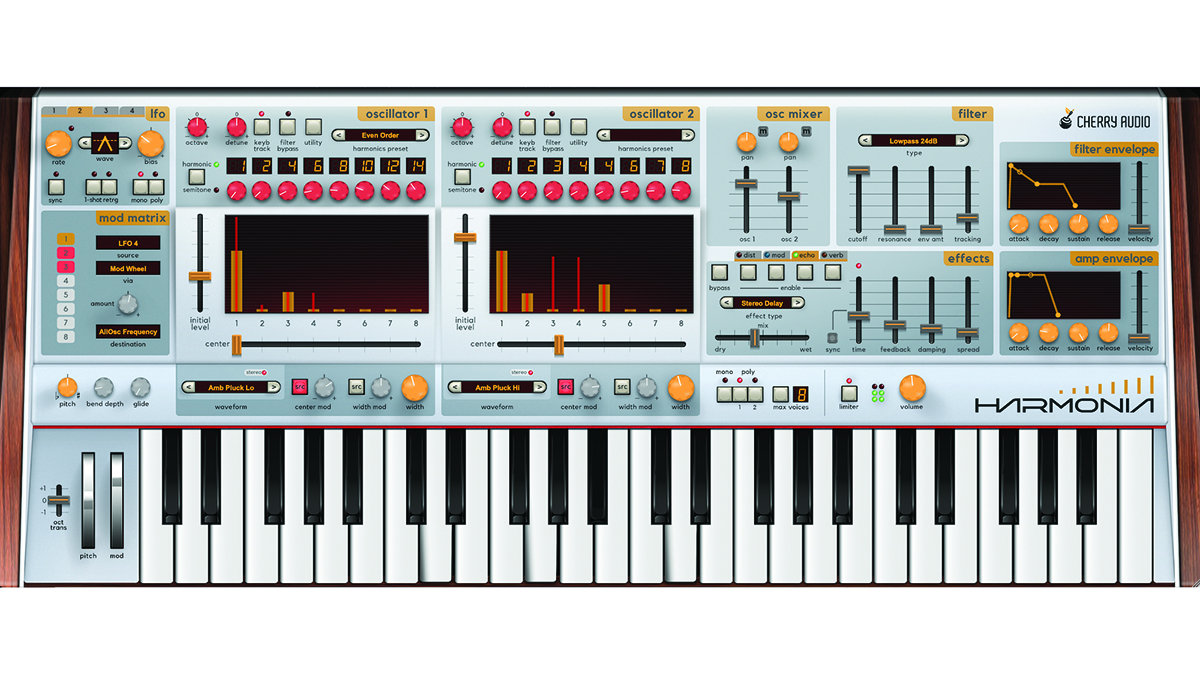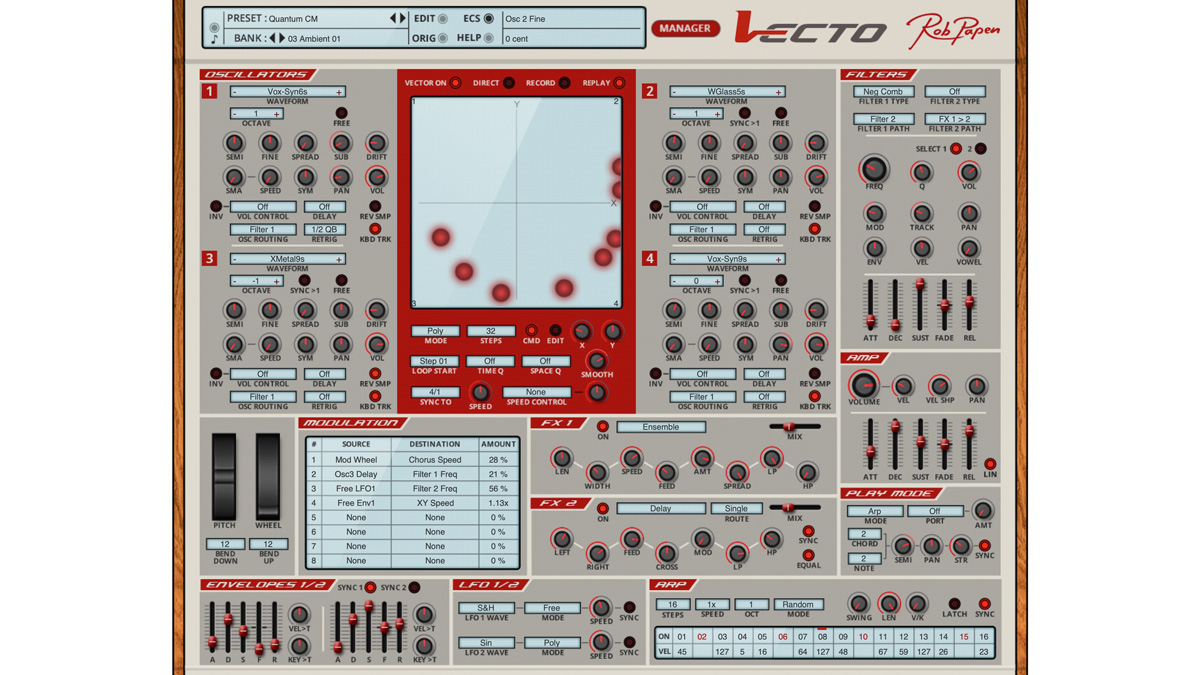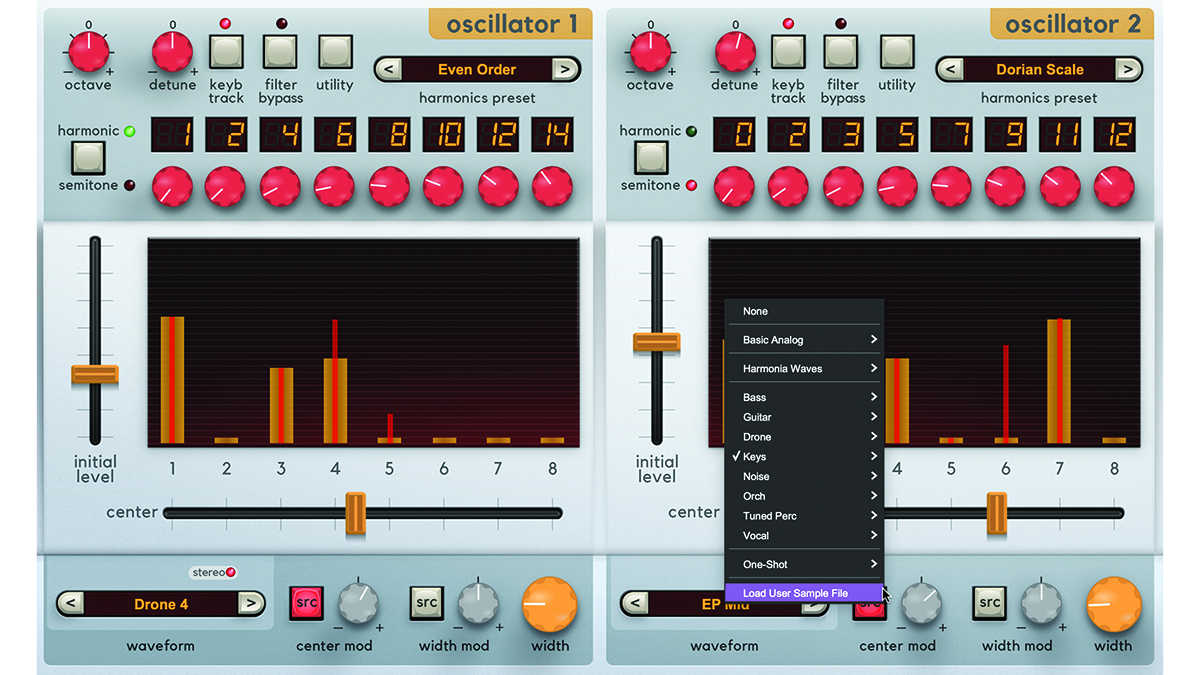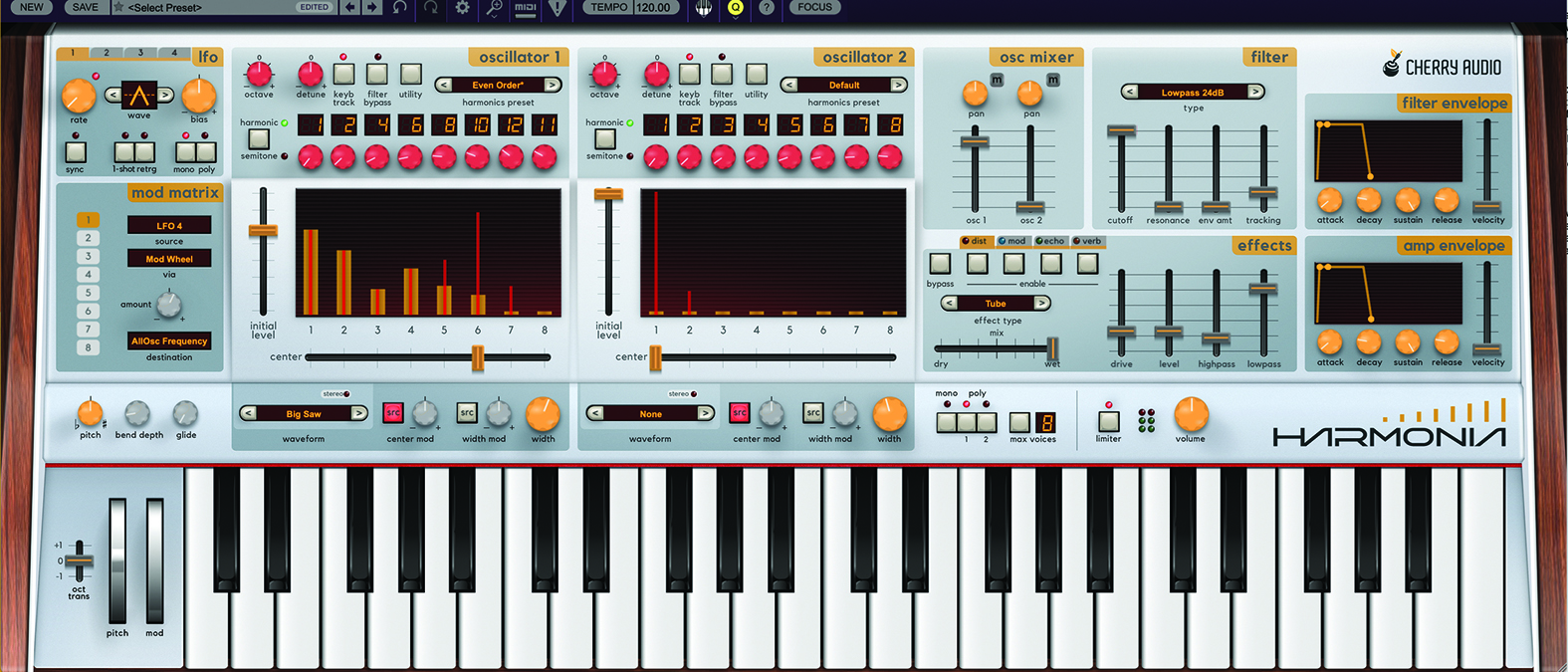MusicRadar Verdict
As musical as it is creatively inspiring, with an interface which is a complete pleasure to use. Harmonia continually rewards.
Pros
- +
Exceptionally versatile synth with enormous creative potential.
- +
The two oscillators are unique and powerful, with lots of subtractive control.
- +
On-board effects section.
- +
Voice count extends from monophonic to 16-note polyphonic.
Cons
- -
It’s just all very positive!
MusicRadar's got your back
Cherry Audio Harmonia: What is it?
macOS 10.13 or above. 64-bit required. Native Apple M1 processor support, including Apple M1 Ultra. 3.4 GHz Quad-Core or M1 CPU with 8GB of RAM recommended.
Windows 7 or above (including Windows 11), 64-bit required. 3.4 GHz Quad-Core computer with 8GB of RAM recommended. Quad-core computer with 8GB of RAM recommended.
We’re all familiar with the basic synthesis building blocks, enshrined into synth-law by Dr Robert Moog back in the ’60s. His subtractive blueprint continues to influence the vast majority of synth designs today, but every now and then, a product breaks the mould, moving in a slightly different synthetic direction.
Cherry Audio’s latest synth does employ degrees of subtractive synthesis: you’ll find filters, envelopes and LFOs onboard, but the exciting stuff begins at the oscillator level.

Cherry Audio Harmonia: Performance and verdict
Time for a quick (and very basic) physics lesson; the fundamental synthesis building block of the musical sound that we hear is called a sine wave. This is a pure sound, with no harmonic overtones, and is relatively quiet as a consequence. If we add further sine waves, at specific multiplied frequencies (pitches), we end up with a richer and louder sound, such as a sawtooth or square wave. The quality and colour of these sounds, and others, is entirely influenced by the harmonics contained within, hence more harmonically rich waveforms generally sound more gratifying.

• Rob Papen Vecto
Vecto offers a four-oscillator construct, which allows programmable vectoring between each oscillator.
• Arturia Synclavier V
Based on the ’80s multifaceted workstation synthesis options, this includes its infamous additive‑based operation.
This idea of using sine waves as building blocks within synths is known as additive synthesis, as you continually add sines to create your timbral construct. However, you need lots of sine waves to build a convincing sound. To assist with this, Harmonia provides a heap of sampled waveforms, replacing the sine-wave notion with more complex samples at source.
Harmonia’s two oscillators are capable of loading a sample, then building a harmonic construct of up to eight tuned harmonics. You can go back to sine basics too – analogue-style sine/saw/square waves are included. But with a host of complex sampled content, from basses and drones, to vocals and orchestral sounds, the basic building block for creation is huge.
Once you’ve selected your wave/sample, the central oscillator display lets you add additional sample playbacks at different frequencies. This adopts the harmonic series, so it’s likely that you’ll make harmonic 1 your main note (fundamental), with harmonic 2 being an octave above, and harmonic 3 a fifth above. However, this does not have to be the case, as you can use the rotary/numbered controls above each of the eight harmonics, to decide which number of the harmonic series you wish to use, from harmonic 1 to 36.
One of the most magical elements is the ability to sweep the user-assigned harmonic range
This makes the whole process very flexible, but moreover, very powerful. Before you know it, you can create the richest of textures, especially when you factor in that most of the samples adopt movement in stereo.
One of the most magical elements is the ability to sweep across the user-assigned harmonic range, using the Center fader, located below the harmonic bar-graph graphic. This can also be narrowed, for creating step-like motion, or widened to create softer sweeps.
Creative punch
Undoubtedly, it’s the oscillators that pack the greatest creative punch, but Harmonia includes a host of familiar subtractive elements, to tame the oscillator components. Oscillators 1 and 2 are blended within the mixer section, before feeding the resonant filter, which provides four shades of low-pass filtering, along with high, band and notch-pass variations. Two ADSR envelopes are hardwired to the filter cutoff and amplifier, while four LFOs may be adopted in various modes, which include polyphonic operation, sync, 1-shot and re-trigger modes. All of these components, and several others, can be exploited as sources for modulation, using the Modulation Matrix.

All mods and harmonics
The overwhelming point that we continue to find with Cherry Audio’s product line, is that it laser-guide its instruments operationally, making them a real joy to use. While the Harmonia oscillators do require a degree of exploration solely to comprehend their capacity, their functionality is such that they’re obvious, once you have the basics in play.
A similar case in point relates to the Modulation Matrix, which invites you to create up to eight modulation paths, from a source to a destination, taking in a manual control along the way, such as the Mod Wheel. The first time we sent an LFO in the direction of the Oscillator’s Centre control, we nearly fell off the chair when witnessing its simplicity, and resultant beauty in tone and texture. The creative scope for Harmonia is vast, and we had plenty of fun trying things out, before employing the onboard effects section to add that layer of sheen, before placing within a track.
Old meets new
Cherry Audio cites Harmonia as a new design, which it is, albeit one that embraces a number of facets from periods of synth history. The result is quite-the-synth power house. Harmonia sounds rich and complex, with familiar sounds from the widest period of synth history imaginable, but step away from the preset patches, and the creative potential expands before your eyes.
MusicRadar verdict: As musical as it is creatively inspiring, with an interface which is a complete pleasure to use. Harmonia continually rewards.
Cherry Audio Harmonia: The web says
"There are plenty of interesting harmonic results to be had, but it’s the sequences that really elevate Harmonia beyond a very capable sound design tool to something that’s more widely useful across musical genres."
MusicTech
Cherry Audio Harmonia: Hands-on demos
Cherry Audio
Audio Tech TV
The Sampleist
Cherry Audio Harmonia: Specifications
- macOS 10.13 or above. 64-bit required. Native Apple M1 processor support, including Apple M1 Ultra. 3.4 GHz Quad-Core or M1 CPU with 8GB of RAM recommended.
- Windows 7 or above (including Windows 11), 64-bit required. 3.4 GHz Quad-Core computer with 8GB of RAM recommended. Quad-core computer with 8GB of RAM recommended.
- CONTACT: Cherry Audio
“Chinese Democracy was a boring record. But calling it Guns N' Roses was not honest. It was totally a solo record”: GN’R’s ex manager takes aim at Axl Rose
“Instead of labouring over a perfect recreation, we decided to make an expanded counterpart”: Chase Bliss teams up with Mike Piera for Analog Man collab based on the legendary King Of Tone
“It’s about delivering the most in-demand mods straight from the factory”: Fender hot-rods itself as the Player II Modified Series rolls out the upgrades – and it got IDLES to demo them













